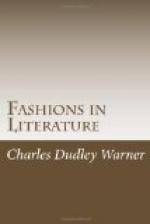The standard of literary judgment, then, is not in the individual,—that is, in the taste and prejudice of the individual,—any more than it is in the immediate contemporary opinion, which is always in flux and reflux from one extreme to another; but it is in certain immutable principles and qualities which have been slowly evolved during the long historic periods of literary criticism. But how shall we ascertain what these principles are, so as to apply them to new circumstances and new creations, holding on to the essentials and disregarding contemporary tastes; prejudices, and appearances? We all admit that certain pieces of literature have become classic; by general consent there is no dispute about them. How they have become so we cannot exactly explain. Some say by a mysterious settling of universal opinion, the operation of which cannot be exactly defined. Others say that the highly developed critical judgment of a few persons, from time to time, has established forever what we agree to call masterpieces. But this discussion is immaterial, since these supreme examples of literary excellence exist in all kinds of composition,—poetry, fable, romance, ethical teaching, prophecy, interpretation, history, humor, satire, devotional flight into the spiritual and supernatural, everything in which the human mind has exercised itself,—from the days of the Egyptian moralist and the Old Testament annalist and poet down to our scientific age. These masterpieces exist from many periods and in many languages, and they all have qualities in common which have insured their persistence. To discover what these qualities




